

Sant’ Anna dei Padri Riformati (1779)
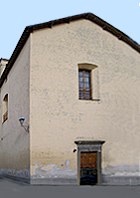
The lintel bears a relief of the Franciscan Order and the inscription : “Echarellus de Cartariis MCCCCCII”. [This presumably refers to a member of the Cartari family - why 1502??]
Chiesa dell’ Annunziata (1571)
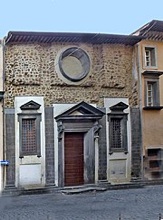
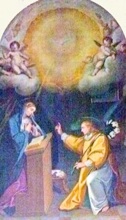
The Confraternita della SS Annunziata built this church using funds that included a bequest from Cornelio Clementini. Ippolito Scalza designed:
-
✴the main altar and two stucco side altars, in 1585; and
-
✴the wooden choir (1592-7).
He also provided a design for the facade, but this work was only partially carried out.
The interior decoration was mostly lost in the 20th century when the building was used as a cinema. However, two altarpieces from the church, both of which are attributed to Cesare Nebbia, survive in Sant’ Andrea:
-
✴the Annunciation (1586), which came from the high altar (illustrated above); and
-
✴the Assumption of the Virgin (16th century), which is sometimes alternatively attributed to Angelo Righi.
San Bernardo (1315) and San Carlo Borromeo (1613-4)
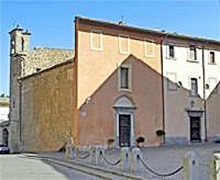
San Bernardo (left) and San Carlo Borromeo (right)
The original church of San Bernardo might have been built by the Templars, who also owned the church of San Matteo (now San Giovannino): St Bernard of Clairvaux had been a a powerful advocate of the fledgling order in the 12th century, and was their patron saint. The order was suppressed in 1312.
The victorious Guelfs built the present church (San Bernardo Nuovo) after their victory over the Ghibellines on the feast of St Bernard, 1313, after which the Filippeschi was banished. The original fabric of this building can be seen from the rear.
The Commune tried to persuade the Gesuits to establish a college in Orvieto in 1584, but this initiative was not immediately successful. They therefore turned to the Padri della Dottrina Cristiana, who moved here in 1588. They opened a school in the nearby Palazzo del Popolo, using funds from a bequest to the city by Muzio Cappelletti, a merchant from Allerona. This school operated until some time after 1621, when the Jesuits established a college in Palazzo Sforza Monaldeschi della Cervara. (The Jesuits and their college moved to SS Apostoli in 1625.)
The adjacent church of San Carlo Borromeo was built three years after the canonisation of St Charles Borromeo (1610).
The two churches were de-consecrated and hidden behind a common facade in 1720, when they were adapted for secular use.
Cappella del Crocifisso del Tufo (16th century)
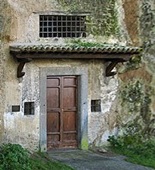
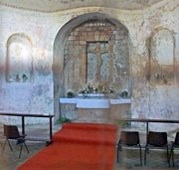
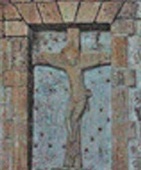
This chapel, which was cut into the rock, is named for the crucifix carved into the tufa on what is now the altar wall. Riccardo Mancini rediscovered it in the 19th century, during his excavation of the nearby necropolis of the Crocifisso del Tufo, which was named for it. The windows are now covered, but you can look through gaps to glimpse this crucifix.
An inscription inside records the somewhat fanciful story of the foundation of the chapel. Apparently, a (presumably Byzantine soldier) called Florianus, who was in Orvieto at the time of Totila (presumably after the final defeat of the Goths in 554, when the city returned to Byzantine control) was unjustly accused of theft and murder. He jumped from the cliff here, praying to a crucifix that he wore, and miraculously escaped harm. His innocence thereby established, he is said to have carved this image in the rock in thanks.
In fact, scholars generally ascribe the crucifix and hence the chapel to the 16th century. It was documented in 1615 and, according to a second inscription, was restored in the 18th century. It belongs to San Giovenale, which stands on the cliff edge above, and is occasionally open for worship.
Oratorio di San Giovanni Battista dei Disciplinati (1578)

The lintel bears the inscription: "SOCIETAS SAN IONNI BATT".
San Giuseppe (1665)
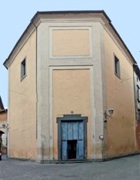
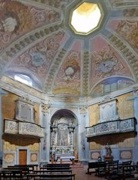
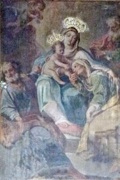
This Baroque octagonal church belonged to the Corporazione dei Falegnami (carpenters’ guild), which also owned the adjacent oratory. Cardinal Bishop Pier Paolo Crescenzi laid the foundation stone in 1665. It was dedicated to St Joseph, who had been chosen as a patron saint of Orvieto in 1652.
There were problems with the design, and construction was not completed until 1685. The complex passed to the Confraternita Nazarena in 1729, and was recently transferred to the parish of the Duomo.
Holy Family (late 18th century)
This highly venerated image altarpiece on the high altar is attributed to Filippo Naldini.
Chiesa dei SS Giuseppe e Giacomo degli Scalzi (1653-7)
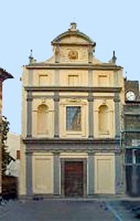
-
✴the Confraternita dei Scalzi (also known as the Confraternita di san Giuseppe), which had been founded in 1615 and which had previously used the church of San Giacomo; and
-
✴the Compagnia del SS Sacramento, which had previously had a chapel in the Duomo.
Cosimo Poli, the cardinal’s nephew, furnished the design. When the merger was reversed in 1675, the Confraternita del Scalzi retained the use of the church.
The facade was not completed until the 19th century.
Santa Lucia dei Canonici (1647-9)
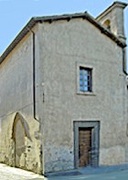
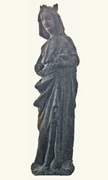
This church belonged to the Camaldolesian monks of the Abbazia di Santa Lucia, Rasa (where is that??). The church was transferred to the canons of the Duomo when Pope Pius II suppressed the abbey. It owes its current appearance to its rebuilding in 1647-9, although a portal from the older church can still be seen in the left wall. The canons ceded the church to the Confraternità degli Artisti after its formation in 1820. It is now used by the Diocese.
Standing figure of the Virgin (late 13th century)
This small wooden figure of the Virgin (illustrated above), which came from the church, is now in the Museo dell' Opera del Duomo. This figure originally depicted the standing Madonna and Child, but it was subsequently modified to represent St Lucy, at which point the figure of the baby Jesus was replaced by lamp. This figure of the baby Jesus has since been lost. The female figure has been returned as far as possible to its original form, but the arms have been destroyed.
Santa Maria del Pianto (1768)
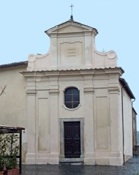
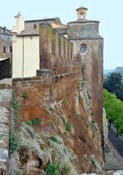
This church, which is dedicated to Our Lady Of Tears, was built by the Spanish nobleman Filippo de Solis on the edge of the city. The church, which has been closed since the Napoleonic period, was nevertheless restored in 2000.
Santa Maria del Velo (1749-51)
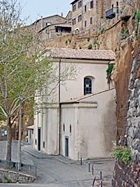
The church, which was built into the cliff, was suppressed in the Napoleonic period and put to secular use. It was incorporated into surrounding structures, all of which have been removed in the recent restoration. Surviving documentation has permitted the faithful restoration of the façade, although nothing of its interior survives.
San Salvatore (established as a nunnery in 1922)
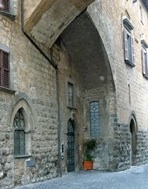
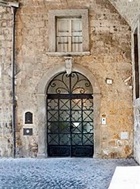
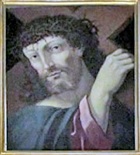
A community of nuns from San Sisto, Rome opened an orphanage here in 1922. They were joined by other nuns from San Paolo. The sisters offer accommodation in what is now the Istituto SS Salvatore) in Via del Popolo.
Christ Carrying the Cross (17th century)
A young man from Orvieto apparently came across this painting (illustrated above) in a stable that he was cleaning after he had been enslaved by Algerian pirates. He brought it with him when he escaped and returned to Orvieto, and it subsequently passed to the ownership of the Palazzi family. Suor Angela Vittoria, who belonged to this family, brought it with her when joined the nunnery of San Paolo in 1653, and it gained a reputation for performing miracles. The last prioress, Enrica Romani, managed to retrieve it after the suppression of 1810. The nuns who moved from San Paolo to San Salvatore in 1922 brought it with them, and it still survives in the institute.
Santo Spirito degli Armeni (1288)
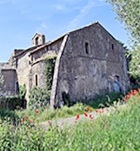
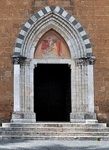


Portal, now in Elements of a fresco of the Annunciation,
now in San Domenico now in the Museo dell’ Opera del Duomo
A record in the episcopal archives records that Bishop Francesco Monaldeschi laid the foundation stone of a new church here at the request of Brother Peter of Armenia. The monks also established a hospice here. The church was abandoned in the early 20th century.
-
✴The Gothic portal (1421) and the fresco of the Annunciation in its lunette were moved to San Domenico in 1934.
-
✴Elements of a fresco (early 15th century) of another fresco of the Annunciation from the church are now in the Museo dell' Opera del Duomo.
Return to Monuments of Orvieto.
Return to: Walk I (Sant’ Anna dei Padri Riformati Chiesa dell’ Annunziata;
San Giuseppe; Santa Lucia; Chiesa degli Scalzi);
Walk II: Oratorio di San Giovanni Battista dei Disciplinati; Santa Maria del Pianto;
Walk III (San Bernardo and San Carlo Borromeo; Cappella del Crocifisso del Tufo;
San Salvatore);
Walk IV (Cappella del Crocifisso del Tufo; Santa Maria del Velo;
Santo Spirito degli Armeni).

